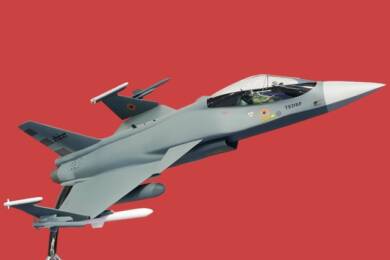
Bengaluru: A new model of India’s under-development Twin Engine Deck Based Fighter (TEDBF), designed for operations from current and future Indian Navy aircraft carriers, has debuted at the 2021 Aero India show in Bengaluru being held from February 3-5.
The twin-engine fighter, being developed to replace Russian-origin MiG-29Ks, has been designed for INS Vikramaditya and India’s first indigenous aircraft carrier, Vikrant, which is likely to be handed over to the Navy sometime this year.
The fighter has been designed for a maximum take-off weight of 26 tonnes with a wing span of 11.7 metres when unfolded and around 7.6 metres when folded and would be a medium weight fighter with a length of around 16.3 metres.
The twin-engine fighter has been designed for INS Vikramaditya and India’s first indigenous aircraft carrier, Vikrant (or IAC-1), which is likely to be handed over to the Navy sometime this year.
It has been optimised for short take-off but arrested recovery (STOBAR) system, which is used for the launch and recovery of aircraft from the deck of INS Vikramaditya (and will also be used on IAC-1).
Vinod Kumar, the project director for the TEDBF program, has said that the work on the fighter programme was on track and the Aeronautical Development Agency (ADA) has received inputs from the Navy and worked out two configurations that satisfy most of the requirements.
The TEDBF is being developed to replace Russian-origin MiG-29Ks.
Kumar said that the ADA received “informal requirements” for the TEDBF from the Navy “very early in 2020.”
The formal operational requirements were given by the Indian Navy in May, after which the ADA worked out two configurations for the TEDBF programme — “Delta-Canard and Trapezoidal with Tail.”
Both these configurations satisfy most of the requirements put forward by the Indian Navy for this programme, the TEDBF project director added.
“We are confident about the configurations. We will go to the Indian Navy, the user, and then seek their view on what is the way ahead to freeze the configuration and fine-tune all the requirements with the Preliminary Staff Qualitative Requirements (PSQR) that will be released by the Indian Navy,” Kumar said.
Kumar revealed that the Delta-Canard configuration of the deck based fighter will undergo low-speed wind tunnel tests soon.
“Requirements that the Navy has put in terms of carrier suitability and performance have been taken into consideration for this configuration,” he said.
ADA started pursuing a twin-engine design (now TEDBF) after the Indian Navy made it clear that it was not interested in a single-engine fighter. This effectively killed the Mk 2 version of the single-engine naval Light Combat Aircraft (LCA).
“The Indian Navy is looking for a twin-engine deck based fighter in lieu of the Tejas Navy Mk-2. With confidence generated from AMCA design, we have developed twin engine competence,” the ADA has said in the past.
Kumar said that the experience gained and technology developed by the ADA in the navalisation of the Tejas will flow into the TEDBF programme. The naval version of the LCA made its first successful ski jump take-off and arrested landing from the INS Vikramaditya on January 12 last year.
The TEDBF will be equipped with a large number of indigenous sensors and weapons. According to the ADA, the fighter will have an improved version of the home-grown Uttam active electronically scanned array radar developed by the Electronics and Radar Development Establishment of Defence Research and Development Organisation (DRDO). Advanced version of India’s first air-to-air missile, Astra, will also be integrated on the TEDBF.








